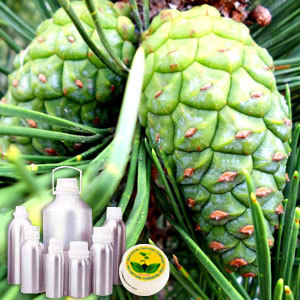Botonical Name | : | Pinus sylvestris | |
CAS # | : | 8021-29-2 | |
Country of Origin | : | Hungary | |
Color & Odor | : | Colorless to pale yellow with Sweet top notes with woody balsamic undertones | |
Solubility | : | Insoluble in water, soluble in alcohol and oils | |
Specific Gravity | : | 0.857 to 0.885 @ 25 °C | |
Optical Rotation | : | -4° to +10° | |
Refractive Index | : | 1.465 to 1.479 @ 20 °C | |
Flash Point | : | >100 °C | |
Major Constituents | : | α-terpineol, linalool & limonene. | |
Plant Part Used | : | Needles and Twigs | |
Extraction Method | : | Steam Distillation |
DESCRIPTION:
Pine Needle Oil is acknowledged for its high therapeutic properties. The refreshing smell of this oil has similarity with the aroma of balsamic, earthy and woody oils. This natural extract is used to treat mental and physical stress and tiredness. Its detoxifying properties deserve special mention. CONSTITUENTS:
This essential oil is packed with compounds like3-carene, a and b-pinene, a and b-phallandrene, bornyl acetate and borneol. AROMATIC SUMMARY / NOTE / STRENGTH OF AROMA:
Top note long lasting woody smell of this oil reminds about the aroma of turpentine oil. BLENDS WITH:
Pine Needle Oil can be mixed with lavender, Cedar wood, sage, niaouli, rosemary and eucalyptus oils. COMMON NAMES:
This aromatic oil is also referred as forest pine oil and Scots oil. USES:
Pine Needle Oil is known for its unique healing attributes. This oil is beneficial for treating physical and mental fatigue. It helps to boot libido. The cleansing properties of this oil are used in vapour therapy. 


































